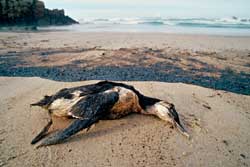|
| |
|
Acute mortality |
|
| |
The Prestige wreck was the worst possible scenario to seabirds on Iberian
coast. The accident occurred in over-wintering season when seabirds tend to
congregate in large numbers on Iberian coast. In addition, the oil released
during the erratic course of the Prestige tanker oil, and further after
sinking, created an extensive oil slick that wind and currents pushed it
into a vast coastal area, from northern Portugal to Brittany (France).
During wintering, many seabirds spend much of their lives in contact with
the sea surface, thus they are not able to escape an oil front, such as
created by the Prestige.
|

|
|
|
 |
|
Oil destroys the waterproofing properties of feathers and once wet, oiled
birds often succumb to hypothermia, smothering and drowning. Moreover, birds
often ingest toxic hydrocarbons while preening which results in poisoning
and death. In the Prestige oil spill, dehydration and exhaustion seem to be
the most likely cause of death, as shown a study based on necropsies of
beached carcasses (Balseiro et al. 2005). Accordingly mass mortalities of
23,000 seabirds were documented during the days after the spill (Garcia et
al. 2003). However, the number of oiled birds recovered after a spill is
only the tip of the iceberg. The total number of birds oiled needs to be
estimated because a large proportion of the corpses do not come ashore.
Indeed, much of the toll from the Prestige, in terms of oiled seabirds,
happened in the open ocean, and thousands of birds' corpses sank before
reaching the shore. Using results of a drift block experiment (simulating
the drift of died auks at sea) to estimate the number of unreported
casualties, unprecedented numbers of seabird deaths were estimated, with
150,00 to 250,000 casualties (Arcos et al. 2004).
The most affected species were diving
seabirds, especially guillemots, razorbills and puffins. Recovery of leg
rings showed that many guillemots and puffins were from colonies in western
Britain, from south Wales to the Scottish islands (Garcia et al. 2003). Since Prestige oil spill occurred in seabird wintering areas remote from
breeding colonies, the effect on mass mortality on seabird population
parameters it is difficult to quantify. Nevertheless, a long-term study on
demography of common guillemots at Skomer Island, Wales, indicated that oil
spills, including the Prestige wreck, doubled the annual over-winter
mortality of adults breeding in this colony (Votier et al. 2005). |
| |
 |
|
|
|
Drift block experiments served
to estimate the number of casualties
|
|
|
Although Prestige oil spill mostly affected
wintering seabirds, hundreds of European shags, a resident endangered
seabird, also perished (Velando et al. 2005). Although the spill occurred 3
months before the onset of shag breeding, this species is largely sedentary
and shags remain around breeding colonies throughout the year. Unfortunately,
a strong female skew in adult mortality was detected in shag casualties
during the Prestige oil spill (Martinez et al. 2006). By the time the
spillage took place (November 2002) shags at sea were most likely females,
and males were already at breeding places. The result of the female skewed
mortality implied a deficit in mates with whom males could reproduce and
hence a decrease in reproductive success at population level. Analysing the
population dynamics of European shag including the demographic effects of
sex-specific mortality, a study (Martinez et al. 2006) revealed that the
mortality of shags caused by the Prestige oil spill implies a reduction of
11% in the breeding population.
|
|
|
|
  |
|
Effects of shag mortality in annual
population growth rates with respect to pre-spill dynamics (Martinez et al. 2006)
|
|
|
|
|
REFERENCES |
|
|
Arcos J.M., D. Alvarez, P.M. Leyenda, I. Munilla & A. Velando 2004. Seabird
mortality caused by the Prestige oil spill: preliminary insights from a
drift blocks experiment. Proceedings of the 8th International Seabird Group
Conference "North Atlantic Seabird Populations: 10, Aberdeen. |
|
|
Balseiro, A., Espi, A., Marquez, I., Perez, V., Ferreras, M.C., Marin,
J.F.G., Prieto, J.M., 2005. Pathological features in marine birds affected
by the Prestige’s oil spill in the north of Spain. J. Wildlife Dis. 41,
371–378. |
|
|
García L., Viada C., Moreno-Opo R., Carboneras C., Alcalde A. & González F.
2003. Impacto de la marea negra del "Prestige" sobre las aves marinas.
SEO/BirdLife, Madrid. |
|
 |
Martínez-Abraín, A., Velando, A., Genovart, M., Gerique, C., Bartolomé,
M.A., Villuendas, E., Sarzo, B., Oro, D., 2006. Sex-specific mortality of
European shags during an oil spill: demographic implications for the
recovery of colonies. Mar. Ecol. Progr. Ser. 318, 271–276. |
|
 |
Velando, A., Munilla, I., Leyenda, P.M., 2005. Short-term indirect effects
of the Prestige oil spill on a marine top predator: changes in prey
availability for European shags. Mar. Ecol. Progr. Ser. 302, 263–274. |
|
|
Votier S.C., B.J. Hatchwell, A. Beckerman, R.H. McCleery, F.M. Hunter, J.
Pellatt, M. Trinder & T.R. Birkhead 2005. Oil pollution and climate have
wide-scale impacts on seabird demographics. Ecol. Lett. 8: 1157-1164. |
|
|
|
 Alberto Velando. Universidade de Vigo
Alberto Velando. Universidade de Vigo |
|
|
